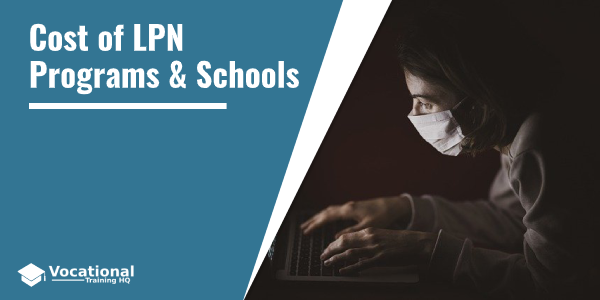Tuition is the vastest portion of the LPN program cost.
The cost can vary greatly depending on your location and state.
Tuition usually refers to the cost of the classroom education you receive in the program.
It doesn’t include some other costs required to complete the program.
These costs can involve textbooks or clinical fees.
The LPN program tuition costs range between $10,000 and $15,000 on average nationwide.
Some programs can cost around $4-5k while others can go up to as much as $30,000.
This may seem like a quite significant amount of money to be paid, but fortunately, there are financial aid options available.
Article Table of Contents
- 1 Monetary Costs of LPN School and How to Save
- 2 Lost Wages During LPN School
- 3 Personal (Non-Monetary) Costs of LPN School
- 4 Ways to Pay for LPN School
- 5 Scholarships for LPN Programs
- 6 FAFSA Essentials for LPN’s
- 7 Requirements for Federal Student Aid
- 8 How to Prepare for and Complete a FAFSA for LPN School
- 9 What to Expect After Completing a FAFSA
- 10 Student Aid Deadlines
Monetary Costs of LPN School and How to Save
It can get overwhelming and confusing while paying for nursing school.
One of the things that are confusing is the loose term of tuition.
Often, this applies only to the cost of the actual classroom education.
In some programs, costs are combined into one number (including tuition, fees, books, etc.).
However, this doesn’t apply to most LPN programs.
Besides the tuition price, students usually have to pay additional costs and fees.
Some of the most common expenses for the LPN programs, besides tuition, include the following:
Books
Books are necessary for any educational program, including LPN programs.
Depending on the course load and specific requirements of the program, books can sum up to a few hundred dollars to more than $1000.
If you shop around for textbooks and other materials you need, you can save a few bucks on this.
Universities and vocational schools have their own bookstores.
However, their items can be overpriced.
You can check out some alternative ways to buy books, for instance, on eBay or Amazon.
Another way to save up on books is through the service called Chegg.
They offer rentals and electronic downloads of books.
This is a great option if you are planning to sell your textbooks after graduation.
However, there are a few things to keep in mind when shopping for books.
Ensure that you get the correct edition and that the ISBN number matches, which is different for every book.
With a different edition number of the textbook, changes can be enormous, even the numbers of pages.
Stethoscope
This is a necessary cost for all LPN students.
This is essential for the right assessment of patients and helps gather valuable information.
Since a stethoscope is a valuable tool, you really need to get one.
The price for them can vary from as little as $20 to several hundred dollars.
But this is the case when you really get what you’re paying for.
Cheap ones can’t be nearly compared to more expensive stethoscopes.
It’s hard to make a proper assessment of a patient with a cheap stethoscope, especially for beginners.
They don’t convey sound as well or loud and can make you miss some observations.
Try to use a cheap stethoscope and then a better one, and you’ll clearly hear the difference.
One of the good brands you can look into is Littmann® Stethoscopes.
Good stethoscopes are available in-store and online and cost about $75 while great ones start at $150 and more.
There are various styles and colors, and even your name can be engraved on them.
It’s also a good idea to get Stethosnap for a good hold of your tool on the uniform.
Uniform and Nursing Supplies
Uniforms include scrub tops and pants.
The styles and colors can vary by school and uniform supplies.
In some schools, only a certain type of scrubs should be used, so you need to check that too.
Uniforms can cost from $20 to a few hundred.
For some programs, a particular number of uniforms should be bought.
Two other common types of required supplies for nurses are the pen-light and bandage scissors.
These items are usually cheap, about $10, and some schools even provide them.
A pen-light is a necessary tool to assess the size of the pupil and to conduct neurological checks.
Bandage scissors can be used for various purposes, and removing bandages is the least of them.
Other supplies you may need include Pocket LPN Guides, organizers, and clipboards.
In the clinical setting, these can be useful materials.
Some of them even come with built-in calculators and other handy tools.
NCLEX-PN Testing
The NCLEX examination is a requirement for all LPN graduates to obtain their license.
The price of it can be about $200, but schools often cover these costs.
Besides paying for the examination itself, you should be well-prepared.
There are various courses and books you can buy that can help you pass it the first time.
Repeat exams will have to be paid for as well, which also costs around $200.
Fees
This is the most unclear category among the expenses.
Fees can range from zero to thousands of dollars.
Common fees can involve parking fees, clinical fees, cafeteria fees, technology fees, and so on.
You can check this information with the school you chose to be sure what fees they charge.
Lost Wages During LPN School
This is not much of an expense for nursing school, but something it can lead to.
In the end, it’s less money.
Many LPN students have jobs they can’t quit during their program.
This can be a problem.
There are options for working prospective LPNs that allow them to study and keep their jobs.
However, it can be extremely hard, especially if you are enrolled in a full-time program.
Often students can’t quit their jobs entirely, but the hours may be cut back.
Therefore, some income can be lost, so you should figure out a budget in advance to prepare for the LPN program.
You need to balance the work and study and devote as much time as you can to nursing education.
Personal (Non-Monetary) Costs of LPN School
LPN school “costs” can include other factors that you need to prepare for and manage properly.
School can be exhausting in many ways and drain your battery fast.
During your program, lack of sleep and other things can cause much stress.
You won’t have as much time as you used to for being with your friends and family because of studying and long hours at the clinic.
So be sure to make the most out of your time with family and others while you are in school.
Ways to Pay for LPN School
Programs for LPNs can be quite costly.
With the costs ranging from 5 to 25 thousand dollars for LPN programs, many students are wondering how they can pay for schooling.
There are some options that can help you pay for it.
All of them have their pros and cons, and often, more than one option are combined to cover the costs.
Cash
A fast and simple way to pay for the LPN program is cash.
You won’t have to deal with debt and obligation to give money back as well as interest.
However, it might not be possible for many students.
In many cases, when students are applying for financial aid, there are small amounts of costs and tuition that students have to cover.
Grants
Another type of financial aid that usually shouldn’t be repaid is grants.
Grants can be awarded by state or federal governments.
Some companies, colleges, organizations, or individuals can provide them as well.
Since grants are “free money”, there are certain requirements and application deadlines to be met.
However, in case of an early withdrawal, students would have to repay the grants.
It is also essential to avoid illegitimate providers and scams which can be quite common these days.
The most famous grant that students can receive is the Federal Pell Grant.
Its amount is based o the financial need, enrollment status (full-time or part-time), cost of education, and how long students plan to attend school.
The maximum Pell Grant in 2013-2014 was $5,645.
In the 2014-2015 school year, it went up to $5,730.
Money can be handled in many ways, just like with other financial aids.
Usually, the money goes directly to the school and is applied to costs.
If there is a remainder, the student gets it back.
Loans
Loans are money that can be borrowed.
The borrower then pays the money back plus some interest.
The interest can be variable or fixed depending on the loan and the provider of it.
Students can acquire two types of loans: federal and private.
Federal loans are funded and subsidized by the federal government.
Private loans are provided by banks, educational institutions, credit unions, and some local or state agencies.
There are a few differences between these types of loans.
The interest in private loans is usually higher, and they can rarely be subsidized.
Most students try to get a federal loan if it’s possible.
The fixed interest in them is lower, and, in most cases, students don’t have to pay them back while in school.
Students can also qualify for subsidized loans when the government pays the interest while students are enrolled for at least half time in school.
With unsubsidized loans, the government tracks the interest while students are in school.
Then, the amount of interest is added to the loan before the repayment period starts.
The borrower has to pay back the principal amount and the interest in this case.
This is called the capitalization of interest.
The amount of the federal loan you can borrow is limited.
Generally, it goes up every academic year, and independent students can usually acquire a higher amount as well.
Federal loans are available directly to students.
The money should be paid back together with interest, but education is a worthwhile investment.
With student loans, many can afford education.
If the financial aid doesn’t cover all the costs, students can apply for other loans too.
They can usually be borrowed by parents, or with the assistance of a cosigner, such as family members or parents.
Work-Study Program
Through the Federal Work-Study program, students can get part-time jobs while in school.
Jobs can be on-campus as well as off-campus.
Students are usually paid directly and can use it to cover educational costs.
Not all the schools participate in the program, so be sure you check this.
Scholarships for LPN Programs
Scholarships are somewhat similar to grants in the way that they don’t have to be repaid.
They are usually merit-based instead of need-based like grants are.
This is a great option to pay for part of LPN school expenses or to cover them entirely.
Students don’t have to pay the scholarships back, and they can be acquired from many sources.
Scholarships are offered by individual groups, non-profit or private organizations, churches, companies, religious groups, and more.
If you are searching for a scholarship online, you should be careful and cautious.
A lot of people offer fake scholarships to scam students.
While doing your research, always use reputable sources.
If you find a scholarship that seems too good to be true, most likely it is.
And last but not least, beware of scholarships that ask for credit card information, social security number, or payment.
These are usually 100% fake scholarships and scams.
Many scholarships are offered directly by the LPN programs you can apply for.
The award amount is usually specific every year, and they are provided to the applicants that stand out as the best among others.
For a scholarship, you have to turn in a written essay together with your application.
In the essay, you should explain why you need the scholarship and why you qualify for it.
If the application is directly for nursing, you should explain why you wish to become an LPN.
Most programs typically have a particular number of scholarships every year and will grant it to the applicants whose essays they find the best.
While working on your application, you should take your time and ensure that both your essay and application are grammatically correct.
Check for spelling mistakes and errors before you submit it.
Also, ask someone else to read through your application, they may spot an error that you could miss.
Pay much attention to detail.
In most programs, scholarship applications have deadlines, and late submissions won’t be accepted.
FAFSA Essentials for LPN’s
FAFSA, or Free Application for Federal Student Aid, is the type of the largest source for financial aid students can obtain.
LPN schools can be expensive, so student aid can be very helpful.
As stated by the name, this application is free to submit.
After it is submitted, students will discover soon what sorts of student aid are available and in which amount.
FAFSA provides financial aid such as federal loans, grants, and work-study programs.
Besides, FAFSA data is often used by many local and state entities or agencies to determine eligibility for other kinds of local or state student financial aid.
FAFSA is valid for one academic year.
If you wish to receive federal student aid, later on, it should be submitted every year.
There are three ways for filing a FAFSA:
- Request a paper FAFSA.
- Download and complete a PDF FAFSA then mail for processing.
- Online at FAFSA website.
Online is, of course, the fastest way to file a FAFSA and obtain aid for LPN school.
In this case, it is processed within three to five days.
Paper applications take from 7 to 10 days.
Also, ensure you’re meeting deadlines when submitting your FAFSA.
Requirements for Federal Student Aid
Before completing a FAFSA, you should meet certain requirements.
Here are the eligibility requirements for federal financial aid:
- Be a citizen of the United States or be an eligible noncitizen.
- Be enrolled in an eligible program.
- Have a valid social security number (SSN).
- Have a record free of drug-related offenses.
- Maintain “satisfactory academic progress”.
- Hold a high school diploma or General Education Development GED certificate.
- Not be in default with the current student loan.
Some loans and grants have other requirements, e.g., demonstrating financial need.
The amount of available student aid can also be affected by the degree being earn as well as a grade level.
If you have doubts about any of this, get in touch with the financial aid office of your school.
How to Prepare for and Complete a FAFSA for LPN School
The timelines on how long it takes to complete a FAFSA for an LPN school depend on the situation, students, and the type of FAFSA application (initial or renewal).
On average, it takes one hour.
However, take your time and make sure everything is accurate and correct.
If you gather the necessary information before you start, you can significantly speed up the process.
You will need the following:
- Social Security Number (or Alien Registration Number if not a United States citizen).
- The recent federal tax return, W-2, and data on any other earned money.
FAFSA is connected to the data retrieval tool of the IRS, which students can use.
So the information on the taxes from previous years will be transferred into FAFSA form automatically. - Bank records and statements of investment (this is not always required).
- Records of untaxed income.
- Electronic personal identification number (PIN).
- If you are considered a dependent student, you will need all of the above data from your parents too.
The exceptions are married, military or veteran students, students over 23, and holders of Master’s or Ph.D. degrees.
Filing the application itself is easy.
You just need to input the required information.
You can be asked to provide additional information.
It will include the educational institution where the FAFSA data should be submitted.
It’s better to list more than one school if you didn’t pick a single one yet.
What to Expect After Completing a FAFSA
Upon completion of the application, it should be processed.
Electronically submitted applications take from 3 to 5 days while paper FAFSA takes from 7 to 10 days.
Once it’s processed, you will receive an email.
After that, you will be able to view your Student Aid Report (SAR).
It’s the document that contains the summary of the entered information, and it has to be checked for accuracy.
This document also contains the Expected Family Contribution (EFC), which is a number used to determine student aid amount and eligibility.
It’s not an estimation of parental contributions or out of pocket costs.
If any additions or corrections are required, they should be completed ASAP.
After the FAFSA is completed, the information is sent to the universities and colleges you listed in the application.
Then, it’s each school’s responsibility to create and distribute financial aid.
Some schools may request additional information, so you should check that too.
The student financial aid is typically sent to students at the same time as admissions paperwork.
This can also vary by school.
Student Aid Deadlines
When planning for federal student aid, it’s essential to keep in mind the deadlines.
For example, in the 2014-2015 school year, the federal deadline was June 30, 2015, and the corrections could be made by September 19, 2015.
Besides federal deadlines, some states may apply their deadlines for financial aid.
State deadlines can be much earlier than federal deadlines, sometimes, even by more than a year.
You can acquire all the information you need about federal and state deadlines, as well as other requirements, for the FAFSA website and the financial aid department of your school.
Colleges may put their deadlines in place as well.
It’s not applicable to all schools, so you can check this information directly with your college.
The best way to keep up with all the deadlines is by submitting the FAFSA as early as you can.
FAFSA can typically be submitted as soon as the tax return of the previous year is completed.
Read the full guide: How to Become a Licensed Practical Nurse




